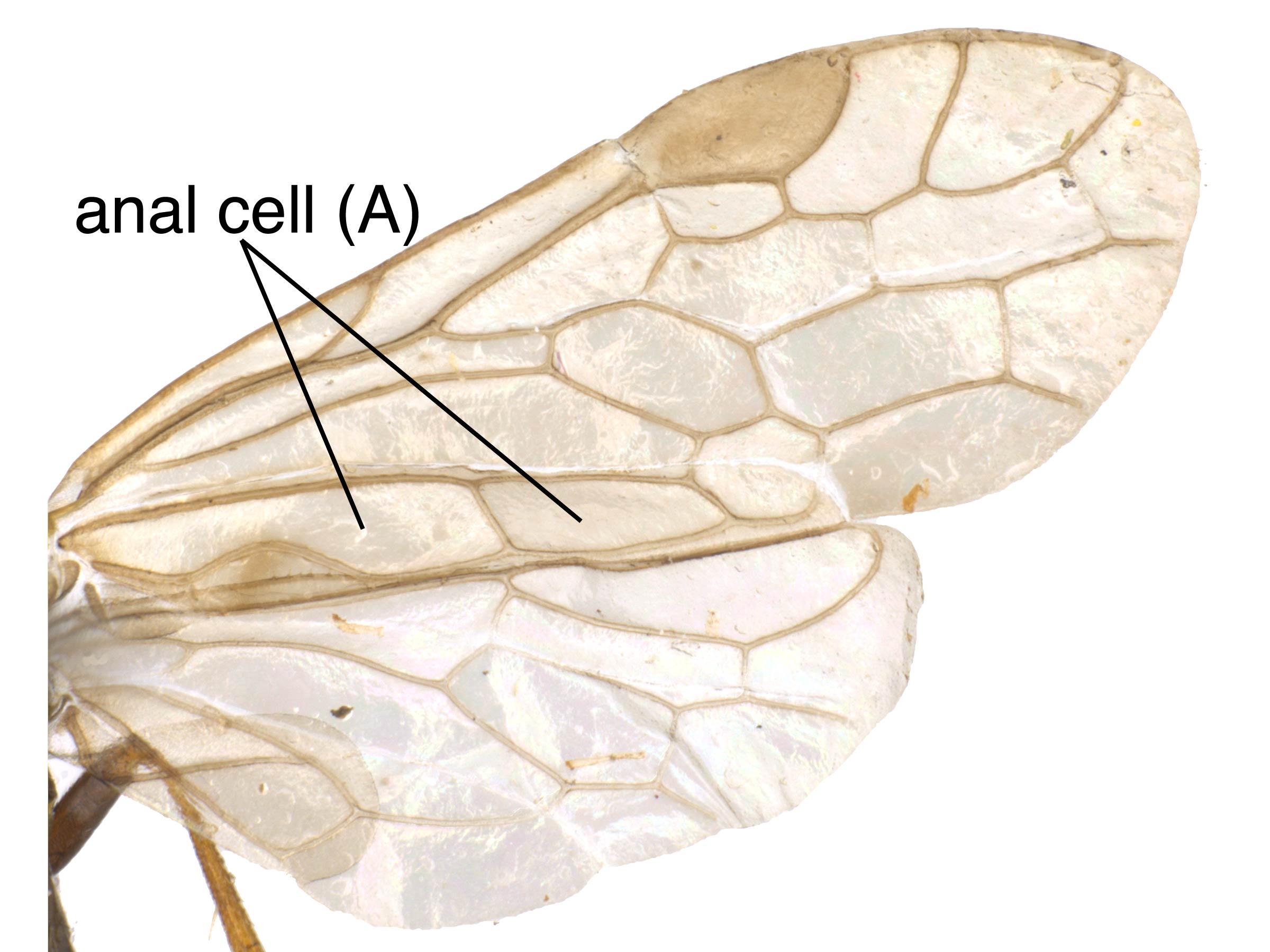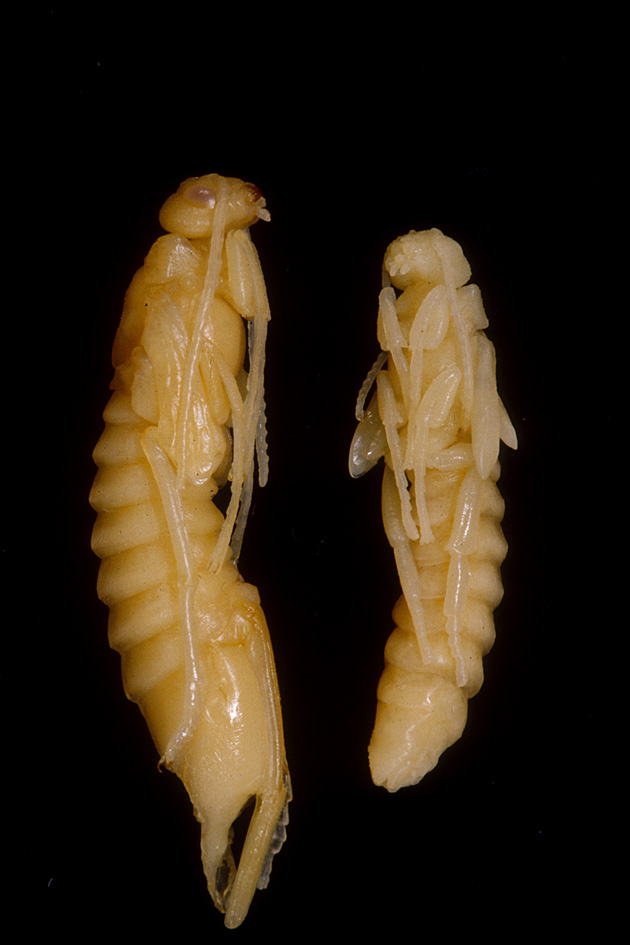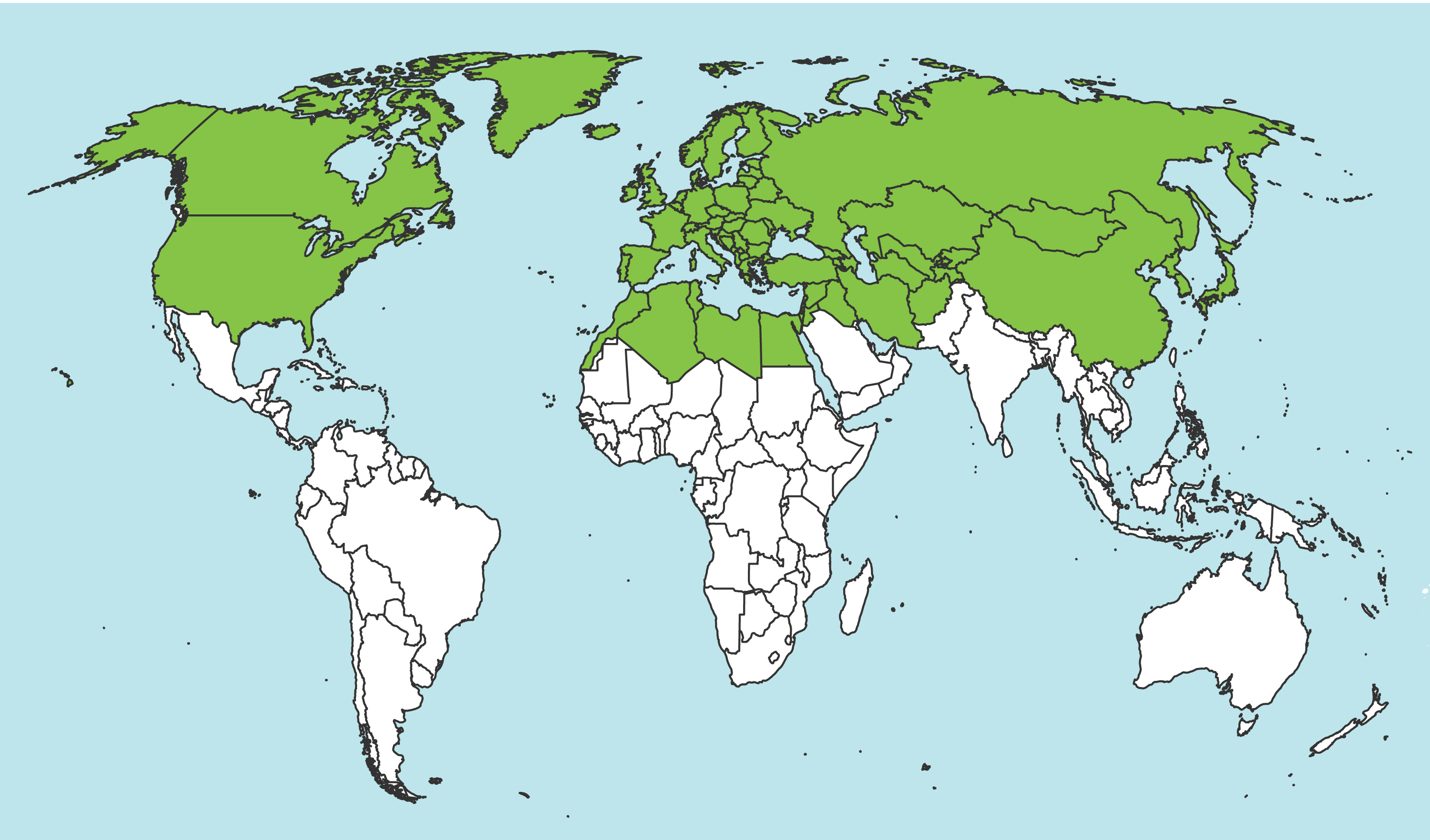Family: Cimbicidae
Family common name: cimbicid sawflies
Subfamily: Abiinae
Genus: Abia Leach, 1817
Subgenera: none
The family Cimbicidae is relatively uncommon and little-studied in North America. However, their large size and metallic reflections make species in the family somewhat conspicuous (Taeger et al. 1998Taeger et al. 1998:
Taeger A, Altenhofer E, Blank SM, Jansen E, Kraus M, Psychorn-Walcher H, and Ritzau C. 1998. Kommentare zur biologie, Verbreitung und Gefahrdung der Pflanzenwespen Deutschlands (Hymenoptera, Symphyta). Kommentierte Bestandsaufnahme 364 (3): 49-135.). Cimbicidae are robust, somewhat bee-shaped, with long hairs and clubbed antennaeantenna:
the sensory organ emerging from the front of the head, usually between the compound eyes and above the clypeus; includes the flagellum, scape and pedicel
 (Smith 1993Smith 1993:
(Smith 1993Smith 1993:
Smith DR. 1993. Systematics, life history, and distribution of sawflies. Pp. 3-32. In: Wagner MR and Raffa KF, eds. Sawfly Life History Adaptations to Woody Plants. University of Minnesota Academic Press. 581 pp.).
Abia is a genus of small cimbicids, they are normally only 10–15 mm in length (Taeger et al. 1998Taeger et al. 1998:
Taeger A, Altenhofer E, Blank SM, Jansen E, Kraus M, Psychorn-Walcher H, and Ritzau C. 1998. Kommentare zur biologie, Verbreitung und Gefahrdung der Pflanzenwespen Deutschlands (Hymenoptera, Symphyta). Kommentierte Bestandsaufnahme 364 (3): 49-135.). They are variable in color, but generally black with faint metallic reflections (Taeger et al. 2010Taeger et al. 2010:
Taeger A, Blank SM, and Liston AD. 2010. World Catalog of Symphyta (Hymenoptera). Zootaxa 2580: 1-1064.).
Worldwide, there are 50 described species restricted to the Northern Hemisphere. Only four occur in North America, one of which was introduced from Europe (Taeger et al. 2010Taeger et al. 2010:
Taeger A, Blank SM, and Liston AD. 2010. World Catalog of Symphyta (Hymenoptera). Zootaxa 2580: 1-1064.).
Key to European species of Abia (including A. lonicerae which was introduced to North America), can be found in Taeger 1998Taeger 1998:
Taeger A. 1998. Bestimmungsschluuml;ssel der Keulhornblattwespen Deutschlands (Hymenoptera: Cimbicidae). In: Taeger A and Blank SM. 1998. Pflanzenwespen Deutschlands (Hymenoptera, Symphyta). Kommentierte Bestandsaufnahme. Goecke amp; Evers, Keltern: 193-205..
 (Nikolic et al. 2007Nikolic et al. 2007:
(Nikolic et al. 2007Nikolic et al. 2007: (Nikolic et al. 2007Nikolic et al. 2007:
(Nikolic et al. 2007Nikolic et al. 2007: each with two simple apicalapical:
each with two simple apicalapical: converging with C then diverging; anal cellanal cell:
converging with C then diverging; anal cellanal cell: constricted in the center (Taeger et al. 1998Taeger et al. 1998:
constricted in the center (Taeger et al. 1998Taeger et al. 1998:Abia can be confused with other Cimbicidae. They can be distinguished by the downwardly diverging eyes, as opposed to parallel or downwardly converging, and the constricted anal cellanal cell:
cell A of either the fore wing or hind wing
 of the fore wingfore wing:
of the fore wingfore wing:
the anterior wing of each pair of wings; usually the largest wing of the pair
 (Taeger et al. 1998Taeger et al. 1998:
(Taeger et al. 1998Taeger et al. 1998:
Taeger A, Altenhofer E, Blank SM, Jansen E, Kraus M, Psychorn-Walcher H, and Ritzau C. 1998. Kommentare zur biologie, Verbreitung und Gefahrdung der Pflanzenwespen Deutschlands (Hymenoptera, Symphyta). Kommentierte Bestandsaufnahme 364 (3): 49-135.).
Abia lonicerae was introduced to New York via Europe in the mid-twentieth century. It has since become established, but because of its low abundance and non-agricultural host plant, it does not have pest status (BugGuide 2019BugGuide 2019:
BugGuide. Accessed January 2019. https://bugguide.net).
In Europe and Asia, the hosts of Abia are herbaceousherbaceous:
describing a plant that does not have a woody stem and is often close to the ground; e.g., grasses, forbs, and vegetable plants
plants in the Caprifoliaceae and Dipsacaceae. The only verified host for North American species is Lonicera spp. (honeysuckle) (Liston et al. 2014Liston et al. 2014:
Liston AD, Savina H, Nagy ZT, Sonet G, and Boeve JL. 2014. Taxonomy, phylogeny, and host plants of some Abia sawflies (Hymenoptera, Cimbicidae). Zootaxa 3821 (1): 125-132. https://doi.org/10.11646/zootaxa.3821.1.9).
The female Abia oviposits into a leaf margin in pairs or small clusters. The young larvaelarva:
the immature stage of holometabolous insects
 feed gregariously on the foliage of a plant and eat all but the main veins of the leaf. Older larvaelarva:
feed gregariously on the foliage of a plant and eat all but the main veins of the leaf. Older larvaelarva:
the immature stage of holometabolous insects
 feed individually. The larvaelarva:
feed individually. The larvaelarva:
the immature stage of holometabolous insects
 of Abia are caterpillar-like, variable in color, but often with a brown or black head capsule and sometimes with black spots and spiracles on the body. At maturity, they can measure up to 33 mm in length (Liston and Späth 2006).
of Abia are caterpillar-like, variable in color, but often with a brown or black head capsule and sometimes with black spots and spiracles on the body. At maturity, they can measure up to 33 mm in length (Liston and Späth 2006).
When disturbed by a predator, larvaelarva:
the immature stage of holometabolous insects
 react by excreting a clear defensive liquid, a behavior called “reflex bleeding”, then fall to the ground, where they become difficult to see. At maturity, the larvalarva:
react by excreting a clear defensive liquid, a behavior called “reflex bleeding”, then fall to the ground, where they become difficult to see. At maturity, the larvalarva:
the immature stage of holometabolous insects
 will fall to the soil surface and build a cocoon in leaf litter. Though it is unknown if they remain pre-pupa or pupapupa:
will fall to the soil surface and build a cocoon in leaf litter. Though it is unknown if they remain pre-pupa or pupapupa:
the intermediate and inactive life stage of holometabolous insects, between larva and adult
 , they overwinter in these cocoons. After pupation, the adult chews a circular hole in the cocoon and emerges (Harizanova et al. 2012Harizanova et al. 2012:
, they overwinter in these cocoons. After pupation, the adult chews a circular hole in the cocoon and emerges (Harizanova et al. 2012Harizanova et al. 2012:
Harizanova V, Stoeva A, and Rector BG. 2012. Host range testing and biology of Abia sercea (Cimbicidae), a candidate for biological control of invasive teasels ( Dipsacus spp.) in North America. Journal of Hymenoptera Research 28: 1-11. https://doi.org/10.3897/JHR.28.3044, Liston and Späth 2006).
The adult is active during the day. Females have been observed feeding on flowers of Apiaceae, particularly Heracleum sp. (cow parsnip), Thysselinum palustre, and Angelica sylvestris (wild angelica) in Europe (Savina and Liston 2009Savina and Liston 2009:
Savina H and Liston AD. 2009. European Abia species feeding on Dipsacaceae, with description of the larva of A. fulgens Zaddach, 1863 (Hymenoptera, Symphyta, Cimbicidae). Bulletin de la Société entomologique de France 114 (3): 265-276.).
World: This genus occurs throughout the HolarcticHolarctic:
describing the region of the Northern Hemisphere that includes both the Nearctic and Palearctic regions
 region, with the highest diversity and abundance recorded in China (Wei et al. 2006Wei et al. 2006:
region, with the highest diversity and abundance recorded in China (Wei et al. 2006Wei et al. 2006:
Wei M, Nie H, and Taeger A. 2006. Sawflies (Hymenoptera: Symphyta) of Chinamdash;checklist and review of research. Pp. 505-574. In: Blank SM, Schmidt S, and Taeger A, eds. Recent sawfly research mdash; synthesis and prospects. Goecke amp; Evers, Keltern.). They are generally uncommon throughout their range, especially in Europe and North America (Harizanova et al. 2012Harizanova et al. 2012:
Harizanova V, Stoeva A, and Rector BG. 2012. Host range testing and biology of Abia sercea (Cimbicidae), a candidate for biological control of invasive teasels ( Dipsacus spp.) in North America. Journal of Hymenoptera Research 28: 1-11. https://doi.org/10.3897/JHR.28.3044).
North America: Abia occurs through most of southern Canada and the United States, excluding the deep south. Abia americana only occurs in the west and is recorded in Alberta, Arizona, British Columbia, California, Idaho, Montana, Oregon, Utah, and Washington. Abia lonicerae is introduced from Europe and is recorded in Maryland, Massachusetts, Pennsylvania, Vermont, Virginia, and West Virginia. The other two Abia species occur in the Northeast and Midwest, as far north as Quebec and as far south as Arkansas (BugGuide 2019BugGuide 2019:
BugGuide. Accessed January 2019. https://bugguide.net).
Map data from: GBIF.org (26 June 2019) GBIF Occurrence Download Abia
Details about data used for maps can be found here.